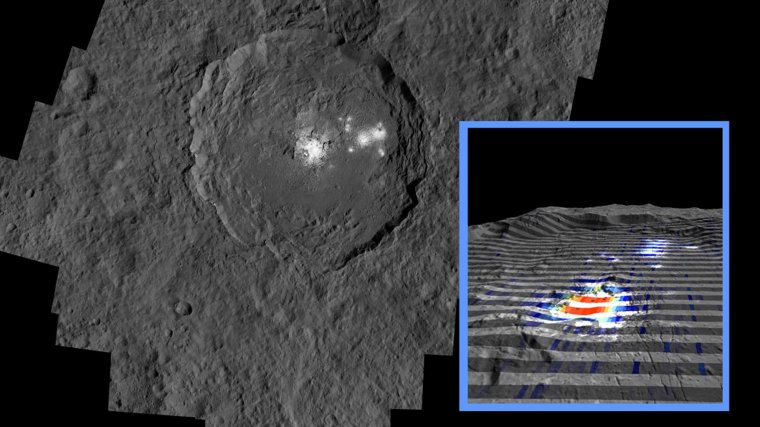| News / Science News |
Recent Hydrothermal Activity May Explain Ceres' Brightest Area
NASA | JUNE 30, 2016
The brightest area on Ceres, located in the mysterious Occator Crater, has the highest concentration of carbonate minerals ever seen outside Earth, according to a new study from scientists on NASA's Dawn mission.

The center of Ceres' mysterious Occator Crater is the brightest area on the dwarf planet. ![]()
At about 80 million years old, Occator is considered a young crater. It is 57 miles (92 kilometers) wide, with a central pit about 6 miles (10 kilometers) wide. A dome structure at the center, covered in highly reflective material, has radial and concentric fractures on and around it.
The dominant mineral of this bright area is sodium carbonate, a kind of salt found on Earth in hydrothermal environments. This material appears to have come from inside Ceres, because an impacting asteroid could not have delivered it. The upwelling of this material suggests that temperatures inside Ceres are warmer than previously believed. Impact of an asteroid on Ceres may have helped bring this material up from below, but researchers think an internal process played a role as well.
The results suggest that liquid water may have existed beneath the surface of Ceres in recent geological time. The salts could be remnants of an ocean, or localized bodies of water, that reached the surface and then froze millions of years ago.
Ceres had interior hydrothermal activity, which pushed these materials to the surface within Occator.
The surface of Ceres contains ammoniated phyllosilicates, or clays containing ammonia. Because ammonia is abundant in the outer solar system, this finding introduced the idea that Ceres may have formed near the orbit of Neptune and migrated inward. Alternatively, Ceres may have formed closer to its current position between Mars and Jupiter, but with material accumulated from the outer solar system.
The new results also find ammonia-bearing salts -- ammonium chloride and/or ammonium bicarbonate -- in Occator Crater. The carbonate finding further reinforces Ceres' connection with icy worlds in the outer solar system. Ammonia, in addition to sodium carbonate and sodium bicarbonate found at Occator, has been detected in the plumes of Enceladus, an icy moon of Saturn known for its geysers erupting from fissures in its surface.
YOU MAY ALSO LIKE





